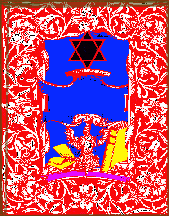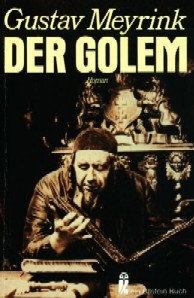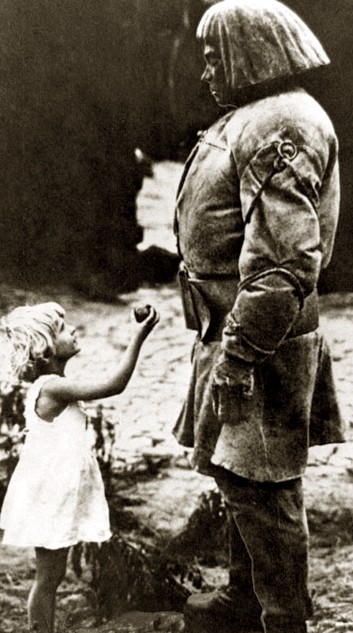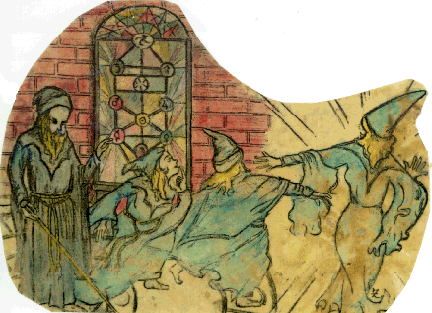 |
"Sefer Yetsirah and Jewish Mysiticsm Time Line
Compiled by Robert Zucker (c) All rights reserved.
|
20th Century (1900AD-1999AD)
1900 Luther, Rudolf "Der Golem" (Novelle)
1902 M.
Grossberg publishes a version of the Dunash Tamim with a commentary
apparently based on the lectures of Isaac Israeli, Abu Sahl's
instructor.
1902 A.E.
Waite published "Doctrine and Literature of the Kabalah." His chapter on
"Sefer Yetsirah" gives a good overview, but he labels the book as an
"arbitary doctrine of a virtue inherent in words and letters" whch "can
only be scandalised at the childish nature of Yetziratic tabulations."
1902 Rathenan,Walter, "Rabbi Eliesers Weib" (Legende)
1903 Salus, Hugo, "Vom Hohen Rabbi Low" (Ballade)
1903 "Otot u-Mo'adim" by Joshua Eisenback of Prystik (Pol. Przystyk) commentary on "Sefer Yezirah" printed.
1904 Torresani, Karl Baron von, "Der Diener" (Novelle)
1906 Artur Holitscher offers his golem drama to the Deutsches Theatre. It was rejected after several changes.
1908 Munzer, Georg, "Der Marchenkantor" (Roman)
1908 Holitscher, Arthur, "Der Golem" (Roman) Ghettelegende in
drei Aufzugen (Berlin 1908). The drama was a psychological
interpretation of the golem legend.
1909 Yudl
Rosenberg publishes a legend of the golem and R. Loew. According to him,
he was publishing an original letter of the Maharal's and a MS written
by R. Loew's son-in-law recounting th deeds of the Rabbi. For the first
time, the Jews are rescued froma blood libel. During Rosenbuerg's time,
false accusations and blood libel became a real threat agin during the
Hislner case in Czechoslovakia in 1899. He published the tales in Hebrew
and Yiddish. They form the basis of Chiajaim Bloch's version, published
in 1919.
1911 letter
to Carl Jung from Sigmond Freud discussing the prevalence of the
doppelganger . Pairs consisting of a nable and base part (usually
brothers) are a motif running through all legend and literature...In
Gilgamesh, this age-old motif of the unequal pair of brothers served to
reprsent the relationship between a man and his libido." ("The Feud/Jung
Letters", Princeton, 1974)
1912 April,
Phineas Mordell published thesis "The Origin of Letters and Numerals
According to the Sefer Yetzirah" in the "Jewish Quarterly Review "April
1912 vol. II, and April 1913 vol. III. The book version was published by
the Dropsie College in Philadelphia Pa, republished by Samuel Weiser,
Inc. "Sefer Yetzirah"" combines oriental and Greek theories. As it was
handed down, it was probably re-written to fit with the culture of the
time. He says:
2 versions of "Sefer Yetzirah" commentators
of 9th c. mixed the original ""Sefer Yetzirah"" with an early
commentary, referred to as ""Sefer Yetzirah" II" All commentaries
written since the beginning of the 10th C. based on this commentary and
not the original. Shorter & longer version (longer printed as an
appendix) Existed in 10th c. earliest written form, 11c (?)found in
Cairo Genizah, published by AM Haberman (1947). Divided into 6 chapters
of mishnayot or halakot. "Sefer Yetzirah" represents permutations in
which letters never repeat themselves but only change their place.
Factors up to 7 are provided, then told to "go and count further..." All
words arising from the combination of the letters are combined and
permuted with the Tetragrammaton, called by "Sefer Yetzirah" as the One
Name YHVH, from which emanated the whole of creation and all of
language. According to "Sefer Yetzirah", the alphabet also had vowels,
which were the letters of the Tet. themselves. The "great secret" of the
3 mothers accord to Dunash Ibn Tamim, are the 3 vowels AIY. The
consonants are dependant on the vowels. The vowels and consonants were
made in the form of a "state and arranged like an army in battle array."
Issac Taylor says, "Like soldiers on parade the characters in the
alphabetic line have been dressed."
1912-13,
published in Philadelphia by the author. It is dated 1914 because no
copies became available of the thesis in america until 1921 because of
the Great War, according to a note on a slip, reported by AE Waite in
1970. It was later published under title "The Origin of Letters and
Numerals According to the Sefer Yetzirah " (Philadelphia), p6.
1913 Translation of "Sefer Yezirah" in French by Duchess C. de Cimara and in a translation by E. Bischoff.
1914 Phineas Mordell interprets "Sefer Yetzirah" in "Jewish Quarterly Review"
1914 Heb, Johannes, "Der Rabbiner von Prag" (Drama)
1915 The
writing of Gustav Meyerink (Meyer) "Der Golem" in 1915 (Leipez) were
inspired by this period. It was later translated into English as "The
Golem" in 1964 and in Yiddish as "Der Golem" by H. Leiveck.(Gershom,
188):
 "Then,
take a bowl full of pure water and a small spoon. Fill it with pure
earth from a mountain, with exact weight of earth before stirring (shake
it) and exact measurement of spoon which to measure. When filled,
scatter it and slowly blow the earth across, over the water. "Then,
take a bowl full of pure water and a small spoon. Fill it with pure
earth from a mountain, with exact weight of earth before stirring (shake
it) and exact measurement of spoon which to measure. When filled,
scatter it and slowly blow the earth across, over the water.
While beginning to blow the first
spoonful of earth,utter a consonant of N. in a loud voice and pronounce
it in simple breah until can no longer blow. While doing this face
downward. and so, begin to sound the combination of consonants and
vowels that will form the head, limbs and parts of the body form all
members in a definite order, til figure emerges."
1916 Hauschner, Auguste, "Der Tod des Lowen" (Novellle)
 1915
the first film, "Der Golem," dealing with the theme of the golem by
Paul Wegener. Second one two years later. The film takes place in the
20th century. 1915
the first film, "Der Golem," dealing with the theme of the golem by
Paul Wegener. Second one two years later. The film takes place in the
20th century.
1916 Antonin Fencl's "Golem. Fantasticka Hra (Golem. A Fantastic Play). Milos Klicman draws the book cover
1917 the
second film, "Der Golem und die Tanzerin " ("The Golem and the Dancer"),
a satirical description of making movies, dealing with the theme of the
golem by Paul Wegener. First one was in 1915. Third one was three years
later.
1918 Wasserman, Jakob, "Christian Wahnschaffe " (Roman)
1918 Singer, Irma, "Wohin der Golem die kranken Manner bringen lieb" (Marchen)
1919
Chaijam Bloch's version of R. Loew and the golem published in Vienna. By
this time, the golem has become well known in arts, writings and film.
1920,
October 29, the premiere of "Der Golem: Wie er in die Welt kam (The
Golem: How He Came Into The World) at the Ufa Palast am Zoo in Berlin.
Paul Wegener's 3rd film dealing with the theme of the golem, takes place
in the 16th century. There are twenty prints of this film left. First
released in 1915 (takes place in the 20th century), and 1917. Wegener
wanted to produce the film in 1914, but did not get the investment money
he needed from the producer. Wegener also had a disagreement in 1928
with Holitscher who accused im of plagarizing his 1908 drama, "Der
Golem".
1921 (Scholem) an edition published in Czech by O. Griese
1921 Wagener published a novel on the golem with some film stills.
1921
summer, "The Golem, wie er in die Welt kam, erdacht und ins Werk gesetzt
(Fimmanuskript)" was shown for almost a year at the Criterion Film
Theatre in New York. Wegener, Paul,
1921-22
Albert Kovessy's musical play "Golem" at Gabel's Yiddish theatre on
116th St. in New York. Gabels' concetion was indebted to Wegeners.
1922 Nottebohm, Horst, "Sun"k (Novelle)
1923 "The
Book of Formation (Sepher Yetzirah)" By Rabbi Akiba Ben Joseph,
translated from the Hebrew with annotations by Stenring, Knut,
Helsingborg, Sweden through London, Rider & Sons. Has several
mistakes. Used Goldschmidt's versions with errors. See Blumenthal.
Reprinted in 1970. Knut Stenring used Gold. Hebrew and German versions
and did not use any Hebrew words independent of Goldsmidt. It is similar
to Mordell's study from "Origin of Letters" Stenring makes some
mistakes in Hebrew, accord to Phineas Mordell in "Jew. Quar. Rev,
191928,p 79). On p 45 he misuses a word.In Jew. Quart. Rev., 1913, p523,
Mordell wrote another "Sefer Yetzirah" article. The Great Secret is
hidden in the three letters A, M, Sh termed as mothers.
1923 (Scholem) an Italian edition of "Sefer Yezriah" published by S., Savini
1926,
November 14, Eugen d'Albert composes an opera with libretto by Ferdinand
d'Albert Lion, entitled "Der Golem." a musicdrama which premiered in
Frankfort an performed in other cities.
1927 The opera "Der Golem" was performed in Leipzig.
1928 Manly
R. Hall published a compilation of the "Sefer Yetsirah" in his "Secrect
Teachings of All Ages," a Rosicurcian and Masonic study of occultism.
1928 Arthur
Holitsche accuses Wegener of plagiarizing his drama "Der
Golem."Ghettelegende in drei Aufzugen (Berlin 1908). The drama was a
psychological interpretation of the golem legend.
1931 a Hungarian edition published by B. Tennen
1932 "Jezirah" by G. Scholem in Encyclopedia Judaica (Berlin)), vol. 9, col. 104ff.
1933 Gershom Scholem begins his study on the golem.
1934 Rosenfeld, Beate "Die Golemsage und ihre Verwertung in der deutschen Literatur" Verg Dr. Han Priebtach, Breslau)
1965
Commentary to "Sefer Yetzirah" published, written by a 13th century
unknown author, possibly in France, and attributed to R. Sa'adiyah Gaon
("Pseduo-Sa'adiyah") published.
1966-68 "Jewish
Quarterly Review" p57-58 "The Sefer Yetsirah and the Original
Tetragrammaton" by Eliyahu Rosh-Pinnah, Berlin (Ernst E. Sttish)
1966 G. Vajda edites a version of Elhanan b. Yakar (c.1240) commentary on "Sefer Yetzirah" (in "Kovez al Yad, 145-97).
1968 Carlos Suarez publishes his edition of "Sefer Yetzirah".
1970 "The
Book of Formation" by Rabbi ben Joseph, translated from 1923 edition
from the Hebrew, with annotations by Knut Stenring, with an introduction
by Arthur Edward Waite, published by KTAV Publishing House, Inc., New
York. (BM 525,A412, ??). Waite sites the 1552 Latin translation by the
Christian mystic G. Postel and printed before the Hebrew edition.
1977 Irving
Friedman, translation and commentary, "Book of Creation," published by
Samuel Weiser. ISBN 0-87728-289-7, Library of Congress Catalog Number
76-15537
1977 second printing of Kalisch 1877 book on "Sefer Yetsirah."
1982 d'Alberts 1927 opera "Der Golem," is revived in Saarbrucken.
1987-present Robert Zucker
begins to re-translate the Sefer Yetsirah on a HyperCard stack called
"Sefer Yetzirah: The Magic of Formation" and composes the manuscript
"Sefer Yetzirah."
1990 "The
Golem" published by Moshe Idel, State Press of New York, Albany. Covers
the development of the golem legend tied with the Sefer Yetzirah.
1990 "Sefer Yetzirah: The book of
Creation in Theory and Practice" by Aryeh Kaplan published (Kaplan died
1983) published. The most indepth English study of each verse with
Hebrew and English translations. Lists of editions, versions and
commentaries. Reproduction of Gates and other.
21st Century (2000AD-present)
2007 QBL Kabbalah software development on Sefer Yetzirah.
© 2007-2011 Bob Zucker. EMOL.org All rights reserved. . No part may be copied, reproduced, republished or
digitally stored without permission from author.
|

 "Then,
take a bowl full of pure water and a small spoon. Fill it with pure
earth from a mountain, with exact weight of earth before stirring (shake
it) and exact measurement of spoon which to measure. When filled,
scatter it and slowly blow the earth across, over the water.
"Then,
take a bowl full of pure water and a small spoon. Fill it with pure
earth from a mountain, with exact weight of earth before stirring (shake
it) and exact measurement of spoon which to measure. When filled,
scatter it and slowly blow the earth across, over the water. 1915
the first film, "Der Golem," dealing with the theme of the golem by
Paul Wegener. Second one two years later. The film takes place in the
20th century.
1915
the first film, "Der Golem," dealing with the theme of the golem by
Paul Wegener. Second one two years later. The film takes place in the
20th century.